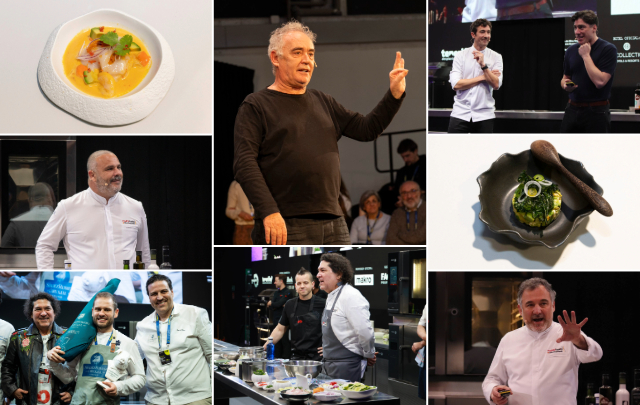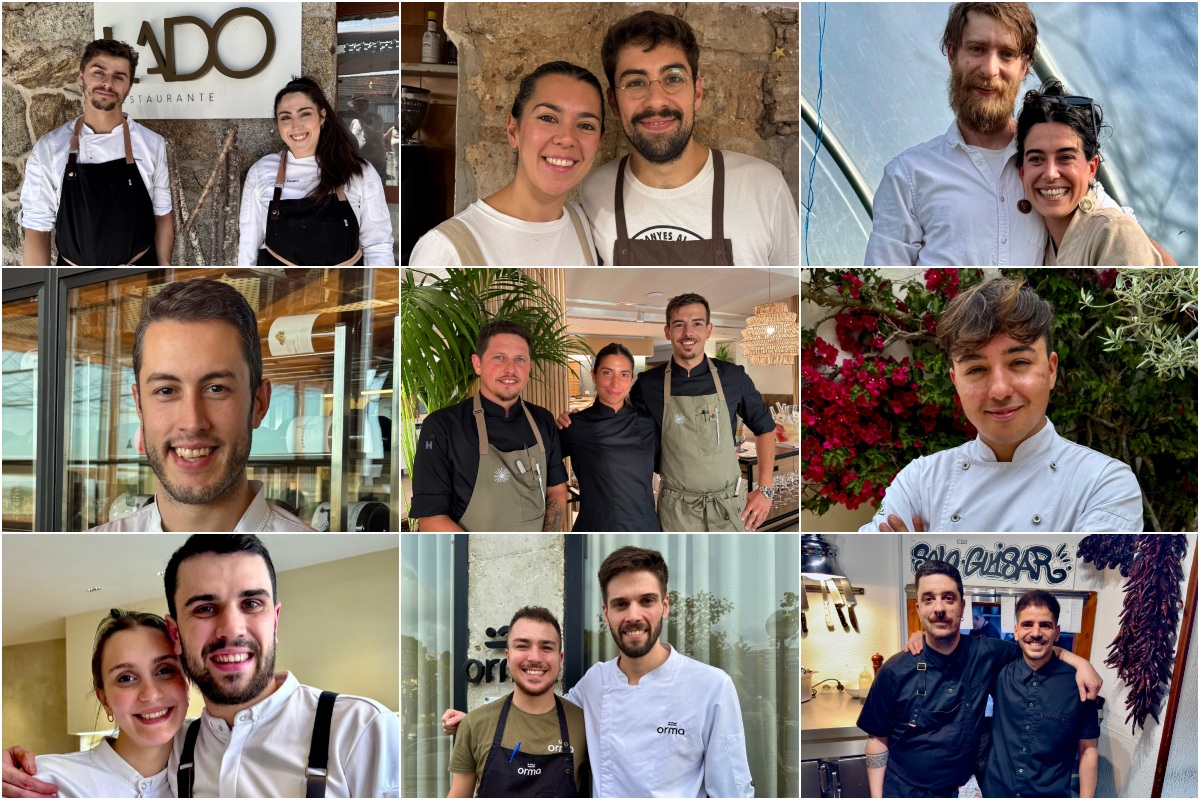News
Madrid Fusión begins by reaffirming the importance of the human factor and exploring the amazing possibilities of AI

The 23rd edition of Madrid Fusión Alimentos de España has opened with the title 'Revolutionaries', with the aim of recalling the revolution that began in Spain thirty years ago, to serve as a substrate for the progress that is currently taking place.
We are commemorating that moment when cuisine broke its boundaries, working alongside science, physics, chemistry and creativity, because the dust of time falls on things very quickly and it must be removed so that a new generation that did not live through it can recognise it and inherit its spirit," said Benjamín Lana, director of Madrid Fusión.
The president and founder of Madrid Fusión Alimentos de España, José Carlos Capel, highlighted the wealth of personalities that the congress brings together this year. The best in the world are here. We have a six-ring gastronomic circus where wonderful things are happening,' he said.
Lana and Capel were in charge of introducing the first speaker, the indefatigable Ángel León, who, as usual, arrived with a bag full of surprises. He revealed the lines of work for the new season at Aponiente (***, El Puerto de Santa María, Cádiz): new sea vegetables that will bring a salty touch to the sweet section; culinary tributes to the historic voyages between Spain and America; and three new features that alone are enough for several headlines. He explained a new technique for flavouring fish by injecting marinades and dressings into the bloodstream through the gills, the commercialisation of his marine sausages (ham, pork, chorizo, sobrasada) with Petaca Chico, and the rehabilitation of the marshes around Aponiente. Working with Ecologistas en Acción has allowed us to recover this wonderful natural space. Now our customers can start the menu with live prawns from the estuary in front of them, and I will leave the kitchen to put on a pair of overalls and accompany them on this journey,' said the Chef of the Sea.
There was not a single break in the morning. After León, Albert Raurich (Dos Palillos*, Barcelona) took to the stage, a follower of Bullini who has used his technical and creative skills to explore Japanese cuisine. In a presentation that focused on the importance of water in this cuisine, he showed a variety of dashis made with chicken, prawns or ham, as well as a technique for curing anchovies using the ancestral method of preserving fish that gave rise to sushi: wrapping salted fish in rice fermented with koji. Koji speeds up the curing process and adds interesting sweet nuances," he says.
Raurich's colleagues in the creative department of elBulli, Oriol Castro, Eduard Xatruch & Mateu Casañas, have taken their joint project, Disfrutar *** (Barcelona), to the top. The best restaurant in the world in 2024 and a creative effervescence that never stops. At this edition of Madrid Fusión, Oriol Castro shared his work with enzymes to produce what he calls 'hydrocarps', fruit honeys and meads made from them. He also presented pasta made with alginates, the aerated biscuits of his 'stalactites and stalagmites' dessert and steak sausage.
From the most technical and innovative cuisine to the most direct, brought to the stage by two other giants of the kitchen, Dabiz Muñoz and Gastón Acurio, in a cebiche heads-up. Acurio made three cebiches without completely abandoning tradition. We don't allow ourselves to be so creative because we are the ambassadors of the dish in the world,' he said. Muñoz, who thanked the Peruvian master for 'teaching and inspiring' him, made three free versions, the last of which he called Gastón's Oriental Ceviche. Acurio said he was 'deeply grateful' for the welcome given to cebiche in Spain, 'both by the chefs who incorporate it into their restaurants and by the public who love it'. His Cebichería La Mar will soon open in Madrid.
The first leader of the revolution to be commemorated at the congress, Ferran Adrià, took to the stage to stress the importance of creation. Only 80 per cent of the 200 restaurants that move the world have fought to break new ground. That's what you call avant-garde,' he said. Joining him on stage was Rubén Zubiri, head chef of the Enigma * restaurant (Barcelona), who explained the digital tool they are implementing: a digital recipe catalogue. Among its uses are purchasing management, the creation of route and product sheets, explanations for the dining room or consultations with the chefs themselves.
Speaking of tools, the gastro-technological tandem of chef Eneko Atxa and physicist Eneko Axpe presented a platform developed with artificial intelligence (AI) to create a daily menu that is profitable for the hotelier and attractive for the customer. Using information on cost price, preparation time, number of guests, type of cuisine, etc., the platform generates the menu, calculates the cost price and offers the recipe, including the times and deadlines for each preparation.
There can be no innovation without acknowledging the past. For this reason, the Madrid edition of Fusión Alimentos de España Revolutionaries paid tribute to one of the country's most important cookbooks, Ruperto de Nola's Libro de guisados, manjares y potajes, a translation of his original work, the Llibre del Coch, published in 1529. The journalist Ana Vega Pérez de Arlucea and the president of Madrid Fusión, José Carlos Capel, acted as masters of ceremonies, while four great chefs from different parts of Spain offered their interpretations of the recipes in the book: Joan Roca, Nacho Manzano, Iván Cerdeño and Pepe Solla.
After the break, the afternoon session began with another look at the future. David Chamorro, R&D chef and creator of the Food Idea Lab, presented the results of his research into light as a kitchen tool and the applications of different types of light in the kitchen, from laser or UV rays to pulsed light, plasma and sunlight. We should be concerned about the light in our restaurants and the light in the chambers that contain the food. We can prevent oxidation, improve colour and flavour, increase vitamin D, remove feather remains from poultry and mushrooms or disinfect kitchen materials,' he said.
Quique, from Dacosta*** (Denia, Alicante), looked back on the three decades that have made him one of the greats of the profession. He began and continues to cook for the love of the art, as his presentation was entitled. From a point of view deeply linked to art, he stressed that 'we must not look to artificial intelligence, but to the traditions and products of the land'. His intention was to show that 'all tradition is in the avant-garde kitchen'.
Mark Donald has made whisky the centrepiece of his menu, although it appears in only three of the 17 courses on offer at his restaurant, The Glenturre Lelique**, in Crieff. Born in Glasgow. Scotland is not associated with haute cuisine and we have a bad reputation, which we want to change by using our fabulous raw materials," he says. The Scot uses elements of whisky distillation in his cooking and prepares smoked dishes with highland peat.
The most expensive food is that which is wasted. Diego Guerrero of DSTAgE ** (Madrid) has been developing techniques for some time to use products in their entirety, including the parts that are usually thrown away. In his presentation, he explained how they use elements such as chestnut shells or leftover chops to create their own flavour enhancers through fermentation and other transformation processes. The next step is for these products to become the protagonists of the dish," he said.
The day ended on a high note with the sensitivity and care with which Jorge Vallejo (Quintonil **, CDMX) captures the essence of Mexico in his dishes, reflecting traditions such as the Day of the Dead or entomophagy in contemporary dishes that invite diners to 'feel rather than experiment'. Conviviality is an essential element of our cuisine, as well as the variety of preparations and products," he said.
He ended the presentations with Iago Pazos's project, Abastos 2.0 (Santiago de Compostela). "It is basically a neighbourhood project where the market cuisine is produced in the market," he said. Abastos is a structure made up of several mini-businesses that form a network that links the primary sector to the table. Their menus always show the distance in kilometres between the origin of the food and the point of sale, in order to highlight and value the origin, the product and the people behind everything they serve.


